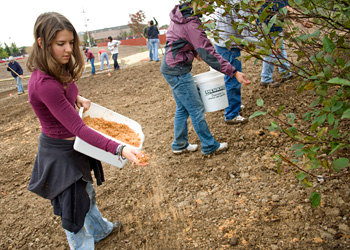Trading turf for prairie
Trading turf for prairie
Thursday, July 8, 2010

A small corner of the campus has started to turn greener thanks to a student proposal and the care and involvement of a professor and a utilities manager.
The south corner of campus is the first glimpse that northbound drivers on Main Street get and that view is improving as a new rolling prairie of a diversity of grasses and flowers are growing to replace the view of a flat turf grass area and community recycling bins. The seeds were planted last October, with some additional planting in June.
“Once a prairie is established, it needs periodic mowing or burning. But it doesn’t require much maintenance in the long run,” said Ryan Sensenig, assistant professor of biology. “And a prairie will never look the same from one year to the next over the coming 20 years. It’s a dynamic, changing process.”
The idea of creating a campus prairie began several years ago in Jerrell Ross Richer’s economics class as a group of students wrote a proposal for the college to save money and energy by developing more native prairie areas on campus. The college’s Environmental Stewardship Committee approved moving forward with changes on the plot behind Newcomer Center. Junior Alana Kenagy (Albany, Ore.), 2010 graduate Andy Brubaker (Goshen) and senior Jake Snyder (Leland, N.C.) worked with Sensenig to give leadership to the project and recruited help from EcoPAX Club members and ecology class students to help prepare the soil and plant the seed.
“The neat part about this is the way it has connected student initiative, physical plant management and the curriculum,” Sensenig said.
A key outcome of the project has been the connections it has nurtured between students, physical plant personnel and teaching faculty.

The prairie project was expanded to include a detention pond as well, which was added after grant funding from the Elkhart River Alliance became available and got Utility Manager and Sustainability Coordinator Glenn Gilbert involved. The detention pond will reduce excess water coming off surrounding parking lots from going into the nearby Elkhart River as quickly and cutting down on flooding.
One benefit of this is that “more and more water should infiltrate over time because of prairie grasses and improved permeability of the soil,” Sensenig said, noting that some areas have a high content of clay.
“By introducing the detention pond, it turned a homogeneous prairie into an area with different plants, because of the topography,” Gilbert said. As not to remove soil from the property when digging out the detention pond, a berm was built to hide the not so attractive recycling bins. “Our intention is to make it look intentional, not neglected,” Gilbert said.
The group used three prairie mixes which all included grasses and flowering plants, including a basic tallgrass prairie seed mix for the banks in the back, a swale mix for the wettest areas and a low profile mix which will cover the majority of the area and includes 30 flowering plants and shorter grasses.
As a student leader on the project, Kenagy said, “I am just really excited to see the land so transformed – shaping the land and planting a diversity of plants – to explore how it affects soil quality and other biological qualities of the area.”
Sensenig sees the way this project has connected disparate parts of campus in significant ways as an experiment in interdisciplinary learning.
“What has intrigued me about this project is that the act of participating in restoration of our landscape has forced us to re-evaluate the way we do education. How can we help students connect with the people and places around them?” he said. “:To the degree that environmental problems are due to the disconnect we have in our lives, the solution has to do with how we reconnect. Restoration of our ‘place’ becomes not just a biological or technical pursuit, but a commitment to socially work in ways that are also restorative. This model of education excites me.
– By Jodi H. Beyeler




